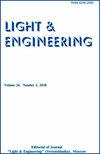彩色光在城市夜间环境中作为建筑形式的工具
IF 0.3
4区 工程技术
Q4 ENGINEERING, ELECTRICAL & ELECTRONIC
引用次数: 0
摘要
在过去的几十年里,夜晚城市的光环境已经成为建筑和行政活动的重要组成部分。今天,照明系统不仅使一个物体或整条街道在晚上“可见”,而且还提供了新的建筑形象的发展。很久以前,人们就欣赏到白色人造光提供的机会与照明的彩色物体一起工作。具有各种光谱特性的白光有时能够极大地影响建筑形式的感知,因为在黑暗适应条件下,它具有“吸收”(关闭)被照明的立面表面的“物体”颜色的能力。特别的是,这些细节创造了一个不同于日常的“夜晚”物体图像,在那里,材料对象中使用的配色方案通常并不重要。相反,在一定条件下的色光不仅可以保持自然采光条件下存在的环境的色彩性质,而且可以以独特的方式发展和统一环境,创造出新的调色板。描述了使用色光布置的夜间环境的主要区域。灯光设计专家在这一领域已经积累了丰富的工作经验。色光的机会,更重要的是,处理它的技术还没有被建筑师充分地欣赏和采用。本文考虑了彩色光作为处理城市夜间条件下物体形态的全功能工具的应用特点。本文介绍了在莫斯科建筑学院(国立学院)实验室进行的一项基于莫斯科多色分析的实验结果,该实验旨在研究物质物体的颜色与彩色光之间的相互作用。通过视觉观察,可以确定为实验选择的彩色滤光片对莫斯科建筑中许多历史时期典型颜色样本的影响。在黑暗中,用带有IL和R, G, B玻璃滤光片的幻灯机照亮了首都建筑中多个历史时期建筑物立面的典型颜色样本,并使用NCS地图集评估了它们的视觉感知变化,然后使用E. Rabkin的地图集通过三个参数(λ, P, P, P)确定了已识别的颜色变化。L)提出了一种假设,即这些研究的结果不仅可以应用于现代城市环境的建筑色彩照明,还可以应用于历史和建筑遗产遗址的修复、保护和互动整合等新的应用领域,使其融入可编程的图像承载环境。本文章由计算机程序翻译,如有差异,请以英文原文为准。
Coloured Light as a Tool for Working with Architectural Form in the Night Environment of the City
For the past decades the light environment of the evening city has become a critical component of the architectural and administrative activities. Today, the lighting systems not only allow making an object or an entire street ‘visible’ in the evening, but also provide for the development of their new architectural image. The opportunities offered by the white artificial light were appreciated to work with the illuminated polychrome objects long ago. The white light with various spectral properties is capable sometimes to influence dramatically the perception of the architectural form, as with its high intensity under the darkness adaptation conditions it has the capability to ‘absorb’ (turn off) the ‘object’ colour of the illuminated facade surface. In particular, the specifics creates an ‘evening’ object image different from the daily one, where the colour scheme used in the material object is often not critical. In contrast, the chromatic light under certain conditions allows not only maintaining the colouristic nature of the environment existing under the natural lighting conditions, but also developing and unifying it in a unique manner, creating a new colour palette. The description of the main areas of the evening environment arrangement with the chromatic light is provided. A significant work experience has been already accumulated in this field by the light design experts. The colour light opportunities and, even more so, the technologies of dealing with it have not been appreciated and adopted by architects to the full extent yet. The article considers the application specifics of the colour light as a fully functional instrument for dealing with the object form under the night urban conditions. The results of an experiment to study the interaction between the colour of material objects and the colour light based on the analysis of Moscow polychrome, which was carried out in the laboratory of the Moscow Architectural Institute (State Academy), are presented. Visual observations enabled to determine the impact of light with the colour light filters selected for the experiment on the colour samples typical for a number of historical periods in the Moscow architecture. The colour samples typical for the facades of buildings erected in a number of historical periods in the capital architecture were illuminated in the darkness with the light of slide projectors with IL and R, G, B glass light filters, and changes in their visual perception were assessed using the NCS atlas, then the identified colour shifts were determined with the use of E. Rabkin’s atlas by three parameters (λ, P, L). A hypothesis was expressed about the possible use of the results of such studies not only in the architectural colour lighting of the modern urban environment, but also in such a new application area as restoration, preservation and interactive integration of the historical and architectural heritage sites into the programmable image-bearing environment.
求助全文
通过发布文献求助,成功后即可免费获取论文全文。
去求助
来源期刊

Light & Engineering
ENGINEERING, ELECTRICAL & ELECTRONIC-OPTICS
CiteScore
1.00
自引率
50.00%
发文量
0
审稿时长
1 months
期刊介绍:
Our magazine
develops comprehensive communication within the lighting community, providing opportunities for discussion and free expression of opinions of specialists of different profiles;
contributes to the convergence of science and engineering practice, the search for opportunities for the application of research results in lighting and technological applications of light;
keeps the scientific community up to date with the latest advances in the theory of the light field, providing readers with operational professional information;
initiates international cooperation, promotes and distributes the results of Russian authors in the international professional community;
provides equal opportunities for authors from different regions of Russia and other countries.
The journal publishes articles in the following areas:
visual and non-visual effects of radiation on humans;
light field theory;
photometry and colorimetry;
sources of light;
ballasts;
light devices, their design and production technology;
lighting and irradiation installation;
light signaling;
methods of mathematical modeling of light devices and installations;
problems of energy saving in lighting, installation and operation of lighting installations;
modern production technologies of lighting products for lighting control systems;
innovative design solutions;
innovations in lighting and lighting design;
the study of the effect on plants and animals, problems of using light in medicine;
problems of disinfection of premises, water and smell elimination with the help of technology of UV radiation using;
problems of light in the ocean and space.
 求助内容:
求助内容: 应助结果提醒方式:
应助结果提醒方式:


